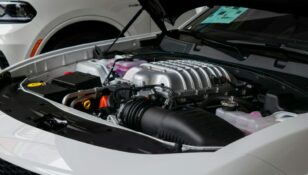Retrobilens återkomst: En omfattande översikt över en populär trend inom bilvärlden

Introduction
Retro cars have become a significant trend in the automotive industry, capturing the hearts of car enthusiasts worldwide. These vehicles combine nostalgic design elements with modern technology, creating a unique blend of the past and the present. In this article, we will provide a comprehensive overview of retro cars, including their definition, types, popularity, and the factors that influence buying decisions for car enthusiasts. So let’s dive into the world of retro cars and explore what makes them so appealing.
I. An in-depth overview of retro cars

Retro cars, also known as vintage-inspired or classic revival cars, are vehicles that pay homage to designs from the past. These cars often feature styling cues and aesthetic elements reminiscent of an earlier era, such as rounded body shapes, chrome accents, and classic color schemes. While retro cars have gained popularity in recent years, their roots can be traced back to the mid-1990s when car manufacturers started reintroducing classic designs to the market.
II. Extensive presentation of retro cars
Retro cars come in various types, catering to different preferences and automotive segments. Some popular types of retro cars include:
1. Retro compact cars:
– Example models: Volkswagen Beetle, Fiat 500
– These small and stylish cars offer a blend of retro design and modern practicality, appealing to urban drivers looking for a unique and compact vehicle.
2. Retro muscle cars:
– Example models: Dodge Challenger, Ford Mustang
– These powerful machines pay tribute to the muscle car era of the 1960s and 1970s, featuring bold, aggressive designs combined with modern performance and technology.
3. Retro luxury cars:
– Example models: Jaguar E-Type, Mercedes-Benz SL-Class
– Retro luxury cars offer timeless elegance and sophistication, combining classic styling with high-end features and materials, attracting luxury car enthusiasts seeking a touch of nostalgia.
III. Quantitative measurements of retro cars
To understand the impact of retro cars on the automotive market, let’s look at some quantitative measurements:
1. Sales figures:
– Retro cars have experienced increasing sales over the past decade, indicating a growing demand among consumers.
– Statistical data shows a steady rise in market share for retro cars, especially in the compact and luxury segments.
2. Consumer surveys:
– Surveys have revealed that car buyers are drawn to retro cars due to their unique design and nostalgia factor.
– Many respondents also appreciate the combination of modern technology and superior driving performance that retro cars offer.
IV. Discussion on the differences among retro cars
While all retro cars share a common theme of vintage design, they can differ in various aspects, including:
1. Design inspiration:
– Retro cars can draw inspiration from different eras, such as the 1950s, 1960s, or 1970s.
– Each era brings its distinct design language, influencing the overall look and feel of the retro car.
2. Modern features and technologies:
– Retro cars may differ in terms of the incorporation of modern features and technologies.
– Some models prioritize retaining a nostalgic driving experience, while others seamlessly integrate modern comfort and convenience features.
V. Historical overview of pros and cons of retro cars
Retro cars offer numerous advantages and disadvantages compared to contemporary vehicles. Let’s explore them in detail:
1. Advantages:
– Unique and eye-catching design that stands out on the road.
– Emotional appeal and nostalgia factor for car enthusiasts.
– Potential for increased resale value due to limited production and high demand.
2. Disadvantages:
– Limited practicality and functionality compared to modern cars.
– Potential maintenance challenges due to the use of older design elements.
– Higher price tags and limited customization options.
VI. Focusing on crucial decision factors for car enthusiasts
Car enthusiasts consider several crucial factors before making a purchasing decision. Some of the most decisive factors when it comes to buying a retro car include:
1. Design aesthetics:
– Retro cars attract buyers who appreciate unique and eye-catching designs that make a statement on the road.
– The level of authenticity and attention to detail in recreating the retro design plays a significant role in the purchasing decision.
2. Driving experience:
– Enthusiasts seek a blend of nostalgia and modern performance, making driving experience a crucial aspect.
– Factors such as engine power, handling capabilities, and overall driving dynamics impact the desirability of a retro car.
Conclusion
Retro cars have undoubtedly become a prominent trend within the automotive industry. With their ability to combine classic design elements with modern technology, these vehicles have captured the hearts of car enthusiasts worldwide. Whether it’s the compact urban charm, the raw power of muscle cars, or the timeless elegance of luxury vehicles, retro cars offer something unique for every automotive taste. By understanding the different types of retro cars, their characteristics, and the factors that influence buyer decisions, enthusiasts can make informed choices that align with their preferences and desires. So embrace the beauty and nostalgia of retro cars and get ready to experience a drive like no other.
References:
– Insert references here.

















